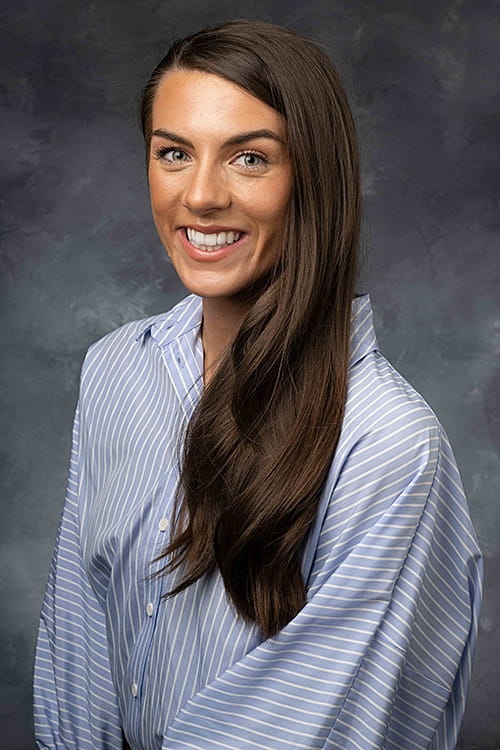
Emily Rogers, PhD student, health and human physiology
Explores exercise's impact on disease
“Emily came to work in my lab from Ireland in 2019 with no prior experience in research. Despite the incredible learning curve, she has adapted very quickly and has excelled…She has been a key lynchpin on our team and our success as a team is in large part because of her.” -Nathaniel Jenkins, assistant professor, health and human physiology
Hometown: Co. Louth, Ireland
Faculty mentor/advisor: Nathaniel Jenkins, PhD, assistant professor, health and human physiology, College of Liberal Arts and Sciences
What is your degree program and expected graduate date? PhD in health and human physiology, May 2023
Please describe your research: Broadly, my research investigates the effects of lifestyle behaviors on the risk for developing both cardiovascular disease (CVD) and type 2 diabetes (T2D). My team and I do this by measuring different physiological markers that are known to predict the development of these diseases (e.g., insulin sensitivity, the ability to metabolize glucose and triglycerides after eating a large meal, blood vessel function, blood pressure, etc.) in human subjects before and after exercise training, physical activity, and sedentary behavior (e.g., prolonged sitting) interventions. A major focus of mine is examining the utility of exercise breaks to improve impairments in vascular insulin sensitivity caused by prolonged sitting. Vascular insulin sensitivity refers to the ability of the blood vessels to dilate in response to insulin, and impairments in this function are viewed as a precursor to CVD and T2D development. Other areas of my research examine how supplements/energy drinks and adverse childhood experiences affect vascular health and responses to exercise.
In simple terms, why does this research matter? CVD kills more people than any other disease in the world, and both physical fitness and sedentary behavior are independent predictors for disease development and premature death. Whilst meeting the 2018 Physical Activity Guidelines for health (i.e., performing 150 minutes of aerobic, and 2 sessions of resistance, exercise per week) is an extraordinarily effective way to reduce disease risk, there is something inherent about sitting for prolonged periods of time that increases our disease risk, even if we are meeting these guidelines. The increasingly popular term “active couch potato” has been coined to describe the type of person who meets the guidelines while also spending the vast majority of their day sitting. With over 80% of U.S. jobs being primarily sedentary, our research findings could help to improve the health of a huge portion of the population.
How soon after starting at the University of Iowa were you able to participate in research? I started my PhD at Oklahoma State University, and when my advisor got a new job here at the University of Iowa, my lab mate and I transferred with him in August 2020. Despite equipment backorders and shipping delays due to the COVID-19 pandemic, our team of three worked together to get our new lab set up, and we were able to begin data collection for our first study here in December 2020.
How has being involved in research made you more successful at the University of Iowa?Being involved in research at UI has given me many opportunities to achieve success inside and outside the university. I have been able to secure grant funding for my dissertation project from the American College of Sports Medicine to answer important questions about the utility of exercise breaks in the workplace to improve the negative effects of prolonged sitting on vascular insulin sensitivity. This success would not be possible without the mentorship and guidance of my dissertation committee members and all the other vascular health, exercise, and physical activity experts in the Department of Health and Human Physiology, who so willingly give their time to help me. These talented faculty, along with an excellent nurse practitioner and several medical doctors from internal medicine and endocrinology here at UIHC (University of Iowa Hospitals & Clinics) have been instrumental to my skillset growth here, not only through promptly answering my questions on how to conduct new physiological techniques (e.g., hyperinsulinemic-euglycemic clamps) and analyses, but also by allowing me to borrow their equipment and space to do so.
What are your career goals and/or plans after graduation? After I graduate, I hope to learn more about the cellular mechanisms associated with physical activity/sedentary behavior in a postdoc position with leaders in this field. Ultimately, I aspire to become an independent researcher in a tenure-track faculty position where I can further examine this interplay between sedentary behavior and physical activity, while exploring different exercise prescriptions to reduce disease incidence. I also wish to build a wellness facility where I can continue to conduct this research while members of the local community come to exercise regularly and practice other healthy behaviors.
Banner location: not on display—
